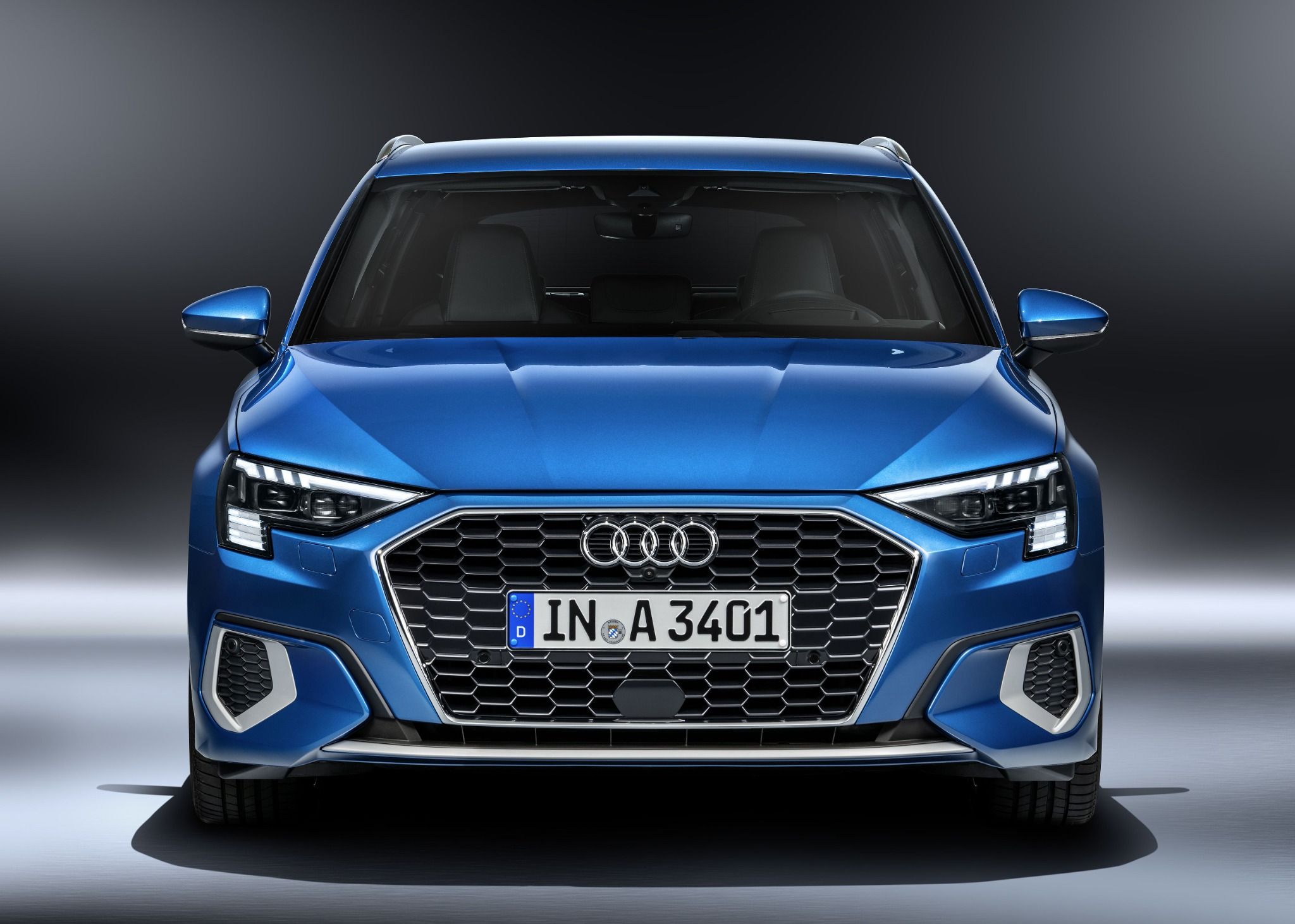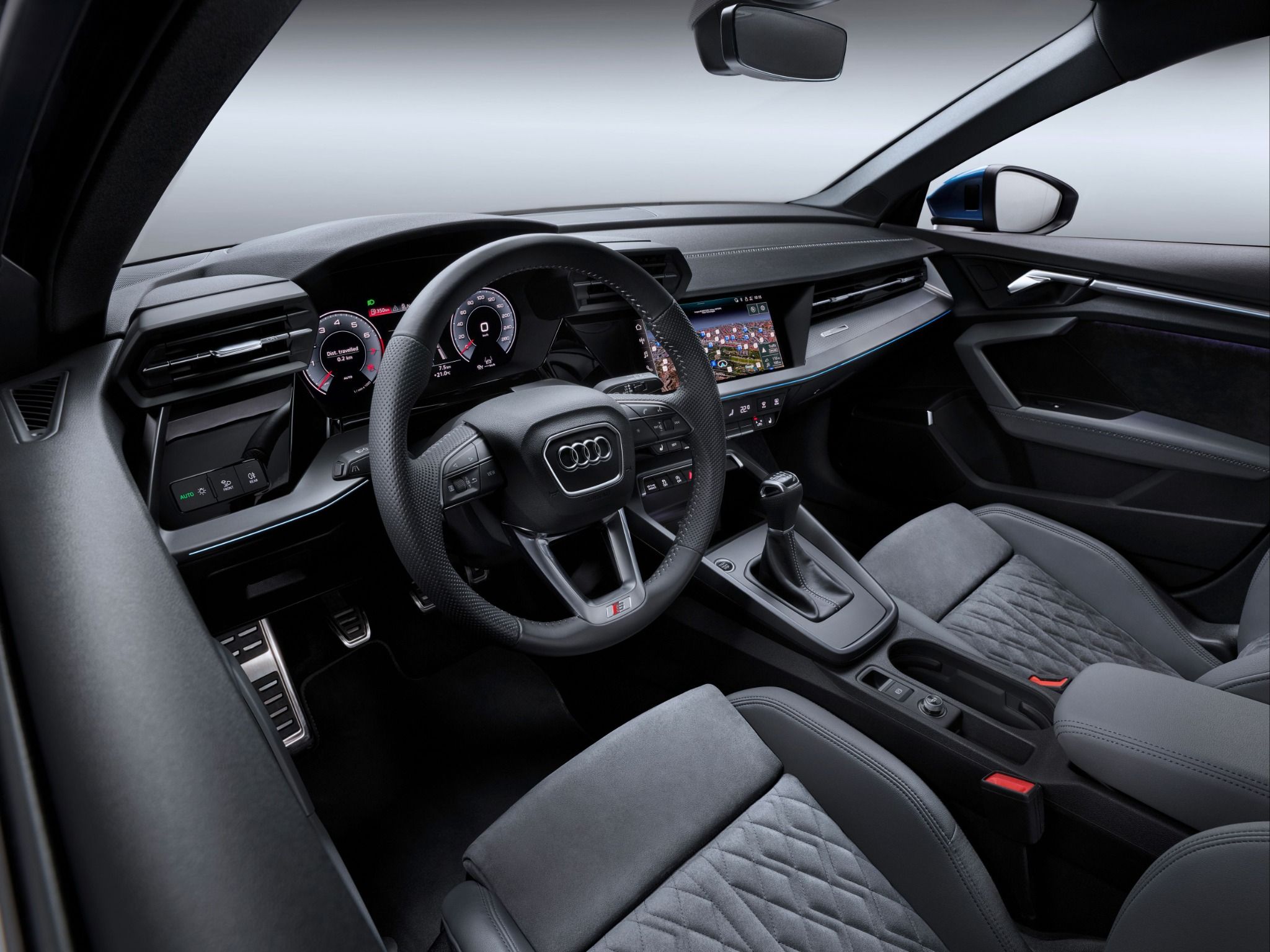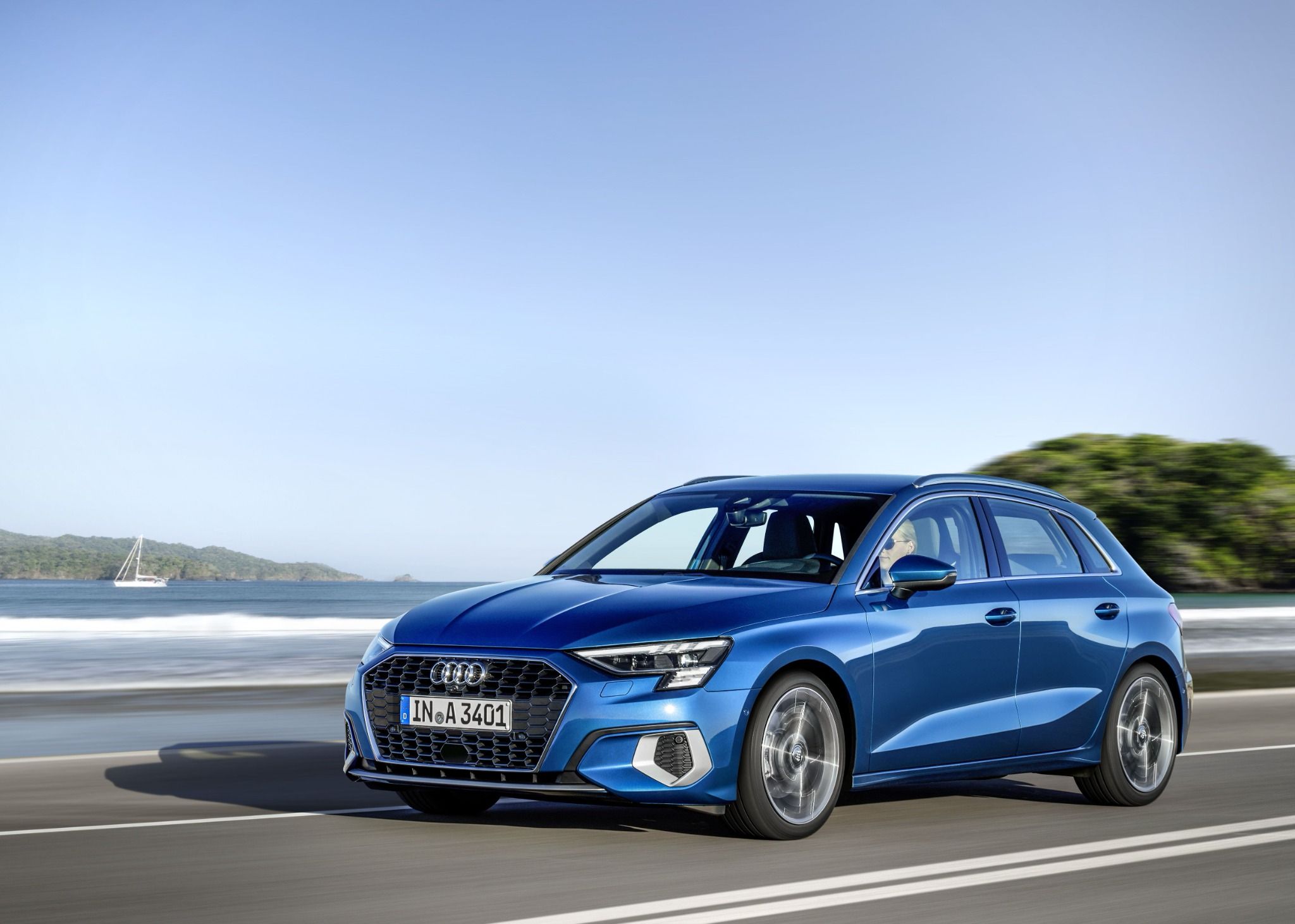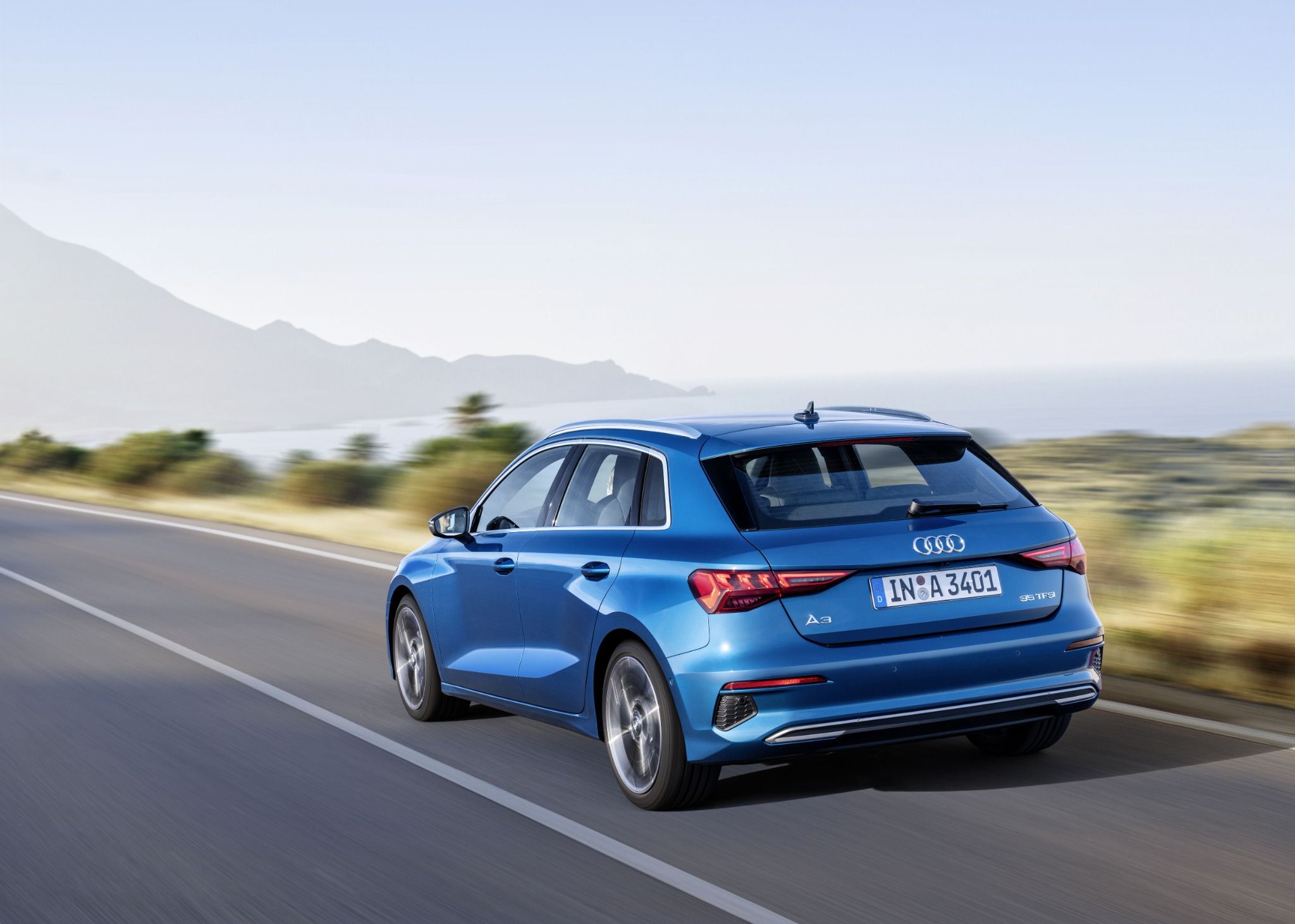The Audi A3 firmly established the premium compact class in 1996. Now, 24 years later, the fourth generation of this highly successful model is ready to make its mark. True to the brand’s Vorsprung durch Technik philosophy, the premium five-door compact once again sets new standards, incorporating an all-new digitalised interior and cutting-edge infotainment, unique new light signatures, powerful engines and a suite of innovative assistance systems enveloped in a completely redesigned, yet immediately recognisable body.
“Each generation of A3 has represented a significant step-change not only for Audi but also for the premium compact class,” said Andrew Doyle, Director of Audi UK. “Our new model is no different and continues to be a torchbearer for Vorsprung durch Technik – it’s fully digital, completely connected and highly intuitive.”

Revolutionised: the exterior and lighting
The new A3 Sportback has an athletic stance and its concave flanks introduce a completely new motif into the Audi design lexicon. They emphasise the dynamic appearance of the compact five-door vehicle, as do the heavily slanting C-pillars above the rear wheels. The shoulder line tapers upward from the headlights to the rear lights.
The surface below it falls inward, accentuating the quattro blisters and highlighting the body shoulder. This creates an intensive play of light and shadow, which is mainly due to the strong contour in the sill area. The lower body line is drawn upward again before it reaches the rear wheel arch. This makes the A3 Sportback appear particularly dynamic.
The front end is dominated by a wide, hexagonal Singleframe with a honeycomb grille. In interaction with the large, angular air inlets and the striking bumper, it visualises the sporty character of the premium compact car. At the rear end, the long roof edge spoiler makes the window appear low. Together with the shoulder line that extends all around the vehicle, the flat rear lights, the diffuser, and the trapezoidal exhaust screens, this effect emphasises the width of the vehicle.
The A3 can also be identified immediately by its headlights. Fitted as standard to Edition 1 and flagship Vorsprung versions, the matrix LED headlights integrate digital daytime running lights for the first time. An innovative pixel matrix consisting of 15 light-emitting diodes shows a specific daytime running light signature depending on the equipment version: While horizontal lines are characteristic of the basic models, two vertical LED lines emphasise the sportiness of the S line exterior. In addition, the matrix LED headlights offer intelligently controlled high beam light, dynamic turn signal light, and dynamic light sequencing when the car is locked and unlocked.
Digitalised: the cockpit
A black-panel look to the instrument panel and centre console, stylish contrasting stitching, striking door handles and a new shifter design all contribute to the high quality feel of the interior of the A3 Sportback. Precise horizontal lines and surfaces with a clear design emphasise the width of the cockpit. This is also achieved by the striking air vent door strip on the passenger side and the curved trim strip below. On the driver’s side, the air vents form an impressive unit with the cover of the instrument cluster. The elements are merged here, which underlines the puristic design.
The cockpit is fully focused on the driver. It uses familiar elements from the brand’s full-size class models and is equipped with a 10.1-inch touch display as standard. It can be used to adjust the settings of the media selection, navigation, and extensive connect services. When the driver selects a function, the system provides acoustic feedback. The centre display is integrated harmoniously in the high-gloss black bezel in the centre of the instrument panel. The entire area is inclined slightly toward the driver, as is the newly developed control unit for climate control located below. The black-panel look is continued to the left of the steering wheel.
The design of centre tunnel console is designed to be particularly ergonomic. There is an innovative shifter integrated in its black-panel surface that offers the driver a completely new operating experience: Using shift-by-wire technology, the compact controller can be pushed and pulled to control the basic functions of the seven-speed S tronic. Next to it is a further innovation: A round, sensory volume control that reacts to circular finger movements.
The Audi A3 Sportback also comes with a 10.25-inch virtual cockpit as standard, which is operated via the multifunction steering wheel. The displays relating to the MMI navigation plus appear in the Audi virtual cockpit, which has many additional functions such as a large view of the navigation map. The Audi virtual cockpit plus with a 12.3-inch display is even more attractive, and is standard on the Edition 1 and Vorsprung trims: It offers three different views, including a sport layout. As a further option, there is a head-up display that projects important information onto the windscreen in colour. The image appears to be floating at a distance of around two metres in front of the driver.

Informed: infotainment with the new MIB 3
The MMI operating concept is powered by a new main unit, the third generation of the modular infotainment platform (MIB 3), which provides ten times more computing power as compared to the MIB 2 in the predecessor model. The MIB 3 cooperates closely with the separate communication box, which performs all tasks relating to connectivity, including telephony and the Audi connect services with LTE Advanced speed, and integrates a Wi‑Fi hotspot. Individual settings can be stored in up to six user profiles. They range from the seat position to the air conditioning settings, frequently selected navigation destinations, and frequently used media.
One major strength of the MMI in the new Audi A3 Sportback is the simple, intuitive operation with a flat menu structure and symbols that users are familiar with from their smartphones. Even the basic equipment with the MMI radio plus features handwriting recognition. The system recognises individual letters, cursive, whole words, and letters written on top of each other. With the MIB 3, natural language voice control is also on board as standard. The A3 Sportback turns into an intelligent conversation partner: The driver can formulate their instructions freely and the dialogue manager responds to them. For example, the system understands questions such as “Where is the nearest Italian restaurant?” and displays matching restaurants nearby. If the customer books the Audi connect navigation & infotainment plus package, the system also performs an online comparison, which improves the rate of recognition and the quality of the results.
More precise: the navigation
The MMI navigation plus, standard on the new A3 Sportback, recognises the driver’s preferences based on previous journeys, allowing it to generate suitable route suggestions. In doing so, it takes statistical experience values on time and traffic density into account, as well as real-time data on the traffic situation. High-resolution satellite images from Google Earth and detailed 3D models of many major European cities also make navigation easier.
The basic services from Audi connect add online traffic information to the navigation, enrich points of interest with photos, opening hours, and user reviews, and provide a weather forecast for the navigation destination.
Synchronised: the myAudi app
Many Audi connect functions are bundled in the free myAudi app, which connects the customer’s smartphone to the A3 Sportback. It can be used, for example, to transfer navigation routes to the MMI and to stream music. The driver can also use the myAudi app to lock and unlock their A3 Sportback remotely, to locate where the car is parked and to be guided to the vehicle.
The many innovations also include the Audi connect key, which will be introduced a few weeks after the market launch. It allows the user to lock and unlock the car and to start the engine with the start/stop button via an Android smartphone.

Sophisticated: the engines
All engines in the new A3 Sportback impress with their powerful torque and sophisticated running characteristics. In the UK, the premium compact model will be launched with two engine versions, both with front-wheel drive: a 1.5 TFSI manual with 150 PS and a 2.0 TDI that outputs 150 PS as an S tronic. In connection with this dual-clutch transmission, the A3 Sportback is fitted as standard with steering wheel paddles. Shortly after the market launch,a second version of the 1.5 TFSI with a mild hybrid system (MHEV) will follow. With this engine, Audi is continuing is electrification strategy in the premium compact class.
A belt alternator starter (BAS) feeds a 48-volt electrical system that integrates a compact lithium-ion battery. When decelerating or during slight brake applications, the BAS can recuperate up to 12 kW of power and feed it to the energy storage unit. When driving off and accelerating from a low rotational speed, it assists the TFSI with up to 9 kW and 50 Nm (36.9 lb-ft) of torque. With the MHEV system, the A3 Sportback can glide with its engine deactivated for up to 40 seconds. The advantage in terms of consumption is up to 0.4 liters per 100 km.
A few months after the market launch, Audi will gradually expand the offer by adding further TDI and TFSI engine versions, including some with quattro drive, as well as a plug-in hybrid in two power levels.
Precisely tuned: the suspension
Even the standard suspension of the Audi A3 Sportback is supremely balanced, combining supple ride comfort with good dynamics. The sensitive and securely regulating electronic stabilisation program completes the dynamic handling characteristics with wheel-selective torque control. Should the front wheel on the inside of the corner lose grip at high speed, it intervenes with a slight brake application. The difference in drive forces turns the car into the bend, allowing the car to follow the steering angle precisely. This makes the handling even more agile, fluid, and safe.
The A3 Sportback is fitted as standard with electromechanical power steering with speed-dependent steering assist. It ensures a precise steering feel at high speeds and positive assistance while parking.
The driver can also control the characteristics of the steering and throttle response as well as the shift points of the S tronic in Audi drive select. The modes available for this are comfort, auto, dynamic, and efficiency. In individual mode, the driver can freely specify their individual preferences to a great extent. In addition, Audi drive select influences comfort and safety systems, such as the automatic air conditioning, matrix LED headlights, the seat belt tensioner, and adaptive cruise control.
For the axle concept, Audi relies on a MacPherson axle with bottom wishbones at the front. Models with an output of 150PS and more are equipped with a multi-link rear axle with separate spring/damper arrangement. Engines with an output of less than this are equipped with a light and compact torsion-beam rear axle. The swivel bearings are made of aluminium.
The wheel portfolio of the new Audi A3 Sportback ranges from 16- to 19‑inch wheels and up to a tire dimension of 235/35, each with a focus on the best possible rolling resistance combined with optimum driving dynamics and performance. The powerful and fade-resistant brakes are actuated by a further innovation, the electric brake booster. Due to the fact that it responds very quickly, the developers were able to increase the air gap between the brake pad and the brake disc slightly.
This solution suppresses friction loss caused by slightly touching brake pads almost entirely, thereby contributing to the high level of efficiency.


Optimised: special concept, body, aerodynamics
The new A3 Sportback offers more space and functionality combined with compact external dimensions. It measures 4.34 metres in length and 1.82 metres in width without the mirrors, and is therefore just over three centimetres larger than the predecessor model. The passengers benefit from this directly: They have more elbow room at the front and rear and more shoulder room in the rear. Without the roof antenna, the new A3 Sportback is 1.43 metres high, which is identical to the third generation, as is the wheelbase of 2.64 metres. By contrast, the slightly lower seat position for the driver is a new feature. This underlines the dynamic character of the premium compact model and benefits the headroom in the first seat row. There are plenty of handy and clever places to store a smartphone, coffee cup, and other items.
Larger belongings can be stored in the luggage compartment, which has a capacity of between 380 and 1,200 litres. The loading floor can be adjusted to different heights, and the rear shelf can be stored underneath it to save space. On request, Audi will deliver an electric tailgate, which can also be opened and closed with a foot motion. Depending on the engine version, the new Audi A3 Sportback has a towing capacity of up to 1,600 kg (braked, at a 12 percent incline) with the optional coupling.
The body is extremely impact resistant, rigid, and acoustically comfortable. With the 1.5 TFSI, the A3 Sportback has an unladen weight (without driver) of just 1,280 kg, making it very light. In the passenger cell, components made of hot-formed steel create a strong compound structure. The front-end flap is made of aluminium.
With a drag coefficient starting from 0.28, the A3 Sportback is particularly aerodynamically efficient, which reduces CO2 emissions and fuel consumption. To achieve this, the aerodynamics developers put a great deal of effort into optimising many areas of the body, for example the exterior mirrors and the underbody, which received a large-area lining.
Aeroacoustics also plays a major part in ensuring that the wind noise is kept to a minimum even at high speeds and providing the customer with maximum comfort in terms of noise levels. Many engine versions have a controllable cooled air inlet: two horizontally positioned louver modules behind the Singleframe that are actuated electrically. They regulate the airflow intelligently and situationally, thereby solving the conflict of objectives between optimum cooling output and aerodynamic efficiency. While driving, they remain closed as much as possible. The brake cooling with a neutral drag coefficient, where the air is guided from the engine compartment through the wheel arch shell to the brakes, is another new feature. When the vehicle is at a standstill, the engine fan generates the air flow.
Well versed: the driver assist systems
The Audi A3 Sportback is equipped with numerous assist systems that provide support when driving in the city or on long journeys. In the Vorsprung, it uses a mid-range radar that takes measurements to the front, as well as two rear-end radar sensors, a front camera, four surround view cameras, and twelve ultrasonic sensors.
With Audi pre sense front, the collision avoidance assist, and the lane departure warning, the premium compact car provides a high level of safety as standard. The interaction of the camera and front radar allows Audi pre sense front to prevent accidents with other vehicles, pedestrians, and cyclists or to reduce the severity of such accidents. The collision avoidance assist also uses the data from this sensor system. It helps the driver steer their A3 Sportback around an obstacle in a critical situation. Assistance is provided in the form of targeted braking of the wheels and applying a little steering torque to correct the steering wheel angle. From a speed of roughly 40mph, the lane departure warning helps the driver to stay in their lane. If the vehicle approaches a boundary line without the driver having activated the turn signal, the system performs corrective steering action to steer the vehicle back into the correct lane. Additional steering wheel vibration can be activated upon request.
The vehicle can be equipped with further driving assist systems by ordering the Driver Assistance Package, for example the lane change and exit warnings. If a lane change is categorised as critical, for example because there is a vehicle in the blind spot, an LED lights up in the exterior mirror.
The exit warning uses the same method plus an acoustic signal to warn the driver about vehicles and cyclists approaching from behind, even when the vehicle is at a standstill. The purpose of this is to avoid possible accidents caused by opening the door. The rear cross-traffic assist is a further optional system. When reversing out of perpendicular and diagonal parking spaces, it warns the driver of approaching vehicles via the MMI display. In particularly critical situations, a warning signal is output and the brakes are applied in addition.

The adaptive cruise assist, which assists the driver with longitudinal and lateral guidance, is the most complex system in the portfolio. The system maintains the speed and distance to the vehicle driving in front and assists with lane guidance by means of gentle interventions in the electromechanical steering up to 130mph. This increases the level of ride comfort during long journeys in particular.
In stop-and-go traffic and in traffic jams, the system brakes the A3 Sportback down to a standstill – this is the case with both automatic and manual transmission. The vehicle is set in motion again automatically or by declutching and accelerating. The adaptive cruise assist is available as part of what is known as the Driver Assistance package. It also includes the efficiency assist, which notifies the driver whenever it would be sensible to take their foot off the accelerator pedal, as well as traffic sign recognition. The two functions allow the adaptive cruise assist to adapt the speed to the speed limits and the course of the road automatically, even without a vehicle driving in front.
The high-beam assist and the emergency assist are also part of the extensive Driver Assistance package. It also includes two parking functions: the park assist and the parking system plus. The former can guide the vehicle into parallel and perpendicular parking spots almost independently, using ultrasonic sensors all around the car. The driver only has to accelerate, brake and shift gears.
In the case of parallel parking spots, the system provides the same assistance when maneuvering out of the parking spot. The system can also be activated during an ongoing manual parking procedure, for example if the driver realises that they approached the parking spot from an awkward angle.
The surround view cameras, which will be available as an individual option after the market launch, are equally useful in city traffic.